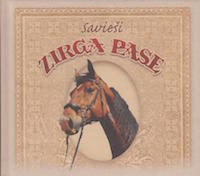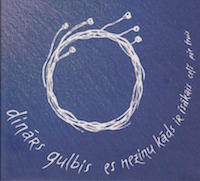Modern classical music can be a challenge to listen to, if not to enjoy. The music is often discordant and highly experimental, forgoing traditional concepts of melody and rhythm and focusing more on new approaches and sonic searches. The music often seems to require a degree in musicology to be understood and enjoyed, as the works can leave audiences mystified. However, with a bit of patience and an open mind, these new works can be appreciated and applauded.
Latvia, with its abundance of talented musicians and composers, is often at the forefront of modern academic music. The variety (and, at the same time, quality) is quite impressive – many Latvian composers are well known worldwide, particularly in the field of choir music.
Some Latvian composers have returned to the traditional approaches to melody and performance – but then there is composer Andris Dzenītis, who is most assuredly at the other end of the spectrum. Among modern Latvian composers, Dzenītis’ compositions are some of the most challenging and difficult to listen to. Eschewing melodies and traditional compositional techniques, Dzenītis works are more like sonic tapestries, exploring new frontiers in sound and performance. His works are certainly not for everyone. Even Dzenītis himself remarked that at times he has difficulty explaining what his works are about in a clear and unambiguous way.
However, intrepid listeners that are willing to invest a bit of time and patience, could very well appreciate — even enjoy — his works. Dzenītis is, for good reason, one of the premiere Latvian composers of the younger generation and his works are not just unique, but often expansive and deep, as well as rewarding for listeners.
Recognizing that the works of Dzenītis are deserving of a larger audience, the Latvian Music Information Centre has released a CD of performances of his works (live recordings from 2009 to 2014) entitled E(GO). This CD is the first release in a new series called Skani that will focus on Latvian composers and compositions.
The collection begins with ‘Preludium. Light’ for symphony orchestra (performed by the Deutsche Radio Philharmonie Saarbrucken-Kaiserslautern and conducted by Karel Mark Chichon). As the title would indicate, the theme of this work is the dawning of light. Beginning with a contemplative, mysterious flute solo, the focus of the work then moves to the trumpet with an ever-expanding crescendo heralding the dawn of a new day. There is at once a sense of magic, but also a sense of trepidation in this dawn, and the work concludes with a subdued duet between harp and bells.
From the chamber music genre there is Dzenītis’ String Quartet No. 1 ‘Trataka. Point noir’ (performed by the Silesian String Quartet). Inspired by the yoga exercise trataka (Sanskrit for ‘gazing’), that involves staring at an object for an extended period of time with the goal of improving concentration. Similarly, the composition begins with an extended unison performance by the quartet, with the goal of focusing both the musicians and the listeners. Reflecting the chaos of modern life, the work itself then becomes chaotic and discordant, and, at the end, returns to a similar unison. Dzenītis studied with composer Pēteris Vasks, and one can detect some of Vasks influences – the harsh strings may remind the listener of Vasks’ ‘Grāmata’ for cello, with its similar shrill introduction.
Dzenītis, like many Latvian composers, has also become known for his choir works. The vocal work on E(GO) is ‘Om, Lux Aeterna’ (performed by the Latvian Radio Choir, conducted by Kaspars Putniņš). Here Dzenītis fuses multiple singing styles and texts – a Latin text performed in a comparatively traditional way combined with Buddhist and Vedic mantras, complete with throat vibrations. The Latvian Radio Choir, with their extensive experience in performing non-traditional vocal works, are the ideal choice for this performance, particularly soloists Agate Burkina (soprano) and Gundars Dziļums (bass), whose performances bring forth the Eastern mysticism and make this work particularly engrossing.
The work ‘E(GO) – Concerto for saxophone and orchestra’ (performed by saxophonist Arvydas Kazlauskas and the Latvian National Symphony Orchestra, conducted by Normunds Šnē), is an expansive and dramatic work, and perhaps Dzenītis’ magnum opus. The title can be considered a bit of a pun, as the theme of the work is letting go of one’s ego (Ego – go!) as the work begins with the saxophone and orchestra locked in struggle – which eventually does resolve itself as the saxophone begins to blend in with the orchestra. Also displaying a Vasks influence, this large form work is full of foreboding and even fear. Kazlauskas’ performance is memorable, as it is not just music but also sounds and vibrations as he portrays the titanic battle.
As this collection began with a ‘Preludium’, it seems appropriate that it would end with ‘Postludium. Ice’ for symphony orchestra (performed by the LNSO, conducted by Karel Mark Chichon). Intended as a postlude to Dzenītis’ opera Dauka, the work returns to the theme of nature, with its variety of sounds and colors depicting the sea and the ice that covers it, stretching out into eternity.
The CD booklet contains extensive notes in Latvian and English about the compositions themselves (which are most helpful and informative in developing one’s appreciation for these works), a biography of the composer, and some commentary from both conductor Chichon and composer Vasks.
Though Andris Dzenītis’ music can make for daunting listening, there is most certainly a method to the madness. Combining various musical styles, various spiritual influences and beliefs, and challenging both performers and listeners to abandon their set ideas about what music should sound like and open their ears to new sounds and experiments, E(GO) displays a unique and creative mind, that combines with exceptionally talented musicians to take the listener on a journey that is often harrowing, but, in the end, remarkably rewarding.
For further information, please visit the composer’s website.
E(GO)
Andris Dzenītis
Latvian Music Information Centre, LMIC/SKANI 040, 2015
Track listing
- Light for symphony orchestra
- String Quartet No. 1 Trataka. Point noir
- Om, Lux Aeterna for choir
- E(GO), concerto for saxophone and orchestra
- Ice for symphony orchestra






